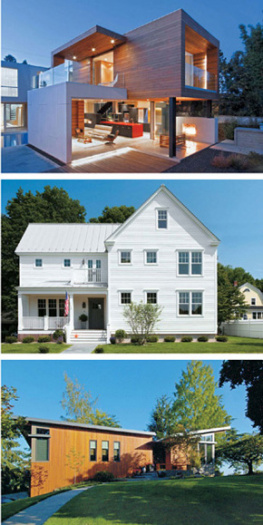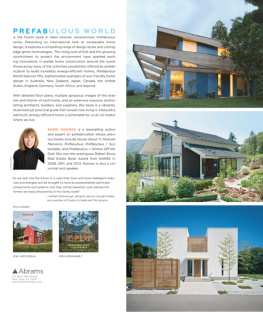


THE NORTHWEST
GREEN HOME PRIMER
Kathleen OBrien and Kathleen Smith
With a foreword
by Denis Hayes

Front cover photos by Michael Moore, Keith Peterson, Art Grice, Bruce Sullivan, Andrea Nelson, Aaron Blake, Stacy Crooks, Alan Scott, and George Ostrow courtesy of Velocipede. Plans courtesy of Robert Harrison Architects.
Back cover photos by Rob Harrison, Wayne Godare, and Mike Seidl courtesy of Fusion Partners LLC. Illustration by Christopher Gutsche and Kathleen Smith adapted from drawings by AHBL.
This book is intended to aid laypersons in the decision making involved in building, remodeling, or purchasing a green home. It offers basic guidelines and suggestions for the reader to consider. Its not intended to substitute for professional consultation on a given project, nor is it a design guide. Each site and each home design may have characteristics that may make any one or more of the suggestions in this book inappropriate. Its your responsibility to work with professionals to determine whats appropriate for your project.
Some jurisdictions dont permit some of the concepts presented in this book. Check with your local building and planning officials if you have any question about specific green building and site development strategies.
Guidance related to health and safety isnt intended to substitute for professional medical consultation. The book is written for the general population and presents ideas that may not be appropriate for an individual with multiple chemical sensitivities or other illness or condition.
We dont mention many products by name, but when we do its intended as an example of something thats available, not a recommendation of a particular product. If we havent mentioned a product by name, its not because we dont think its a worthwhile product but only because we dont want to be in the business of representing products in this book. A list of trademarks mentioned in this book appears on page 292.
Copyright 2008 by Kathleen OBrien and Kathleen Smith. All rights reserved. | Library of Congress Cataloging-in-Publication Data |
Published in 2008 by
Timber Press, Inc.
The Haseltine Building
133 S.W. Second Avenue, Suite 450
Portland, Oregon 97204-3527, U.S.A.
www.timberpress.com | OBrien, Kathleen (Kathleen Anne)
The Northwest green home primer / Kathleen OBrien and Kathleen Smith.
p. cm.
Includes bibliographical references and index.
ISBN-13: 978-0-88192-797-9
1. Ecological houses--Pacific states. I. Smith, Kathleen (Kathleen Frances) II. Title.
TH4860.O27 2008
643.1--dc22 |
Printed in the United States of America. | 2007027196 |
Text printed on acid-free, recycled paper. |
FRONTISPIECE: The Cunningham-Pinon residence, Portland. PHOTO BY ANDREA NELSON. |
For our children and grandchildren:
Chris, Scott, Don, Fred, Matt, Alice, Oliver, Ellie, Zach, Tommy, and Stratton.
And for all the children of the world,
And for the earth that they will inherit.

CONTENTS
Acknowledgments
12 Operations and Maintenance
FOREWORD
When we were organizing the first Earth Day in 1970, our hope was to shine a spotlight on several troubling environmental trends.
Earth Days organizers had been born into a world where roughly 30 percent of the worlds population lived in urban areas, and about 80 cities had populations of more than 1 million people. By 1970, the environmental impacts of separating living communities from their sources of food, energy, and water were becoming significant. Water and air pollution, loss of topsoil, and degraded landscapes were problems crying out for solutions. Over time, environmental agencies would be formed, federal regulations would be passed, and grassroots organizations would pound the pavements to raise public awareness and changes in behavior.
By 2000, when many of the students whod organized Earth Day had become grandparents, they were living in a world where almost half of the worlds population lived in urban areas and more than 400 cities had populations of over 1 million people. At the same time, some of the progress made in earlier years by environmental agencies and activist groups was being reversed.
Today, humans are triggering a wave of extinction unmatched since the last time a major asteroid hit the planet. We have laced all living organisms on the planet with complex, biologically-active, manufactured compounds with unknown consequences. Our clear cutting, bottom trawling, and massive hydroelectric projects have caused effects similar to those of massive earthquakes and volcano eruptions.
And, of course, we are changing the earths climate.
As citizens, we must address these issues at the ballot box, in our businesses, and through local organizations. We can also play a significant role as homeowners.
The lighting, space conditioning, and appliances used in buildings now comprise the largest source of greenhouse gas emissions in the world. The good news is that the technical opportunities for dramatic reductions in building energy usewithout any loss of amenity or productivity, and at little or no economic costare literally stunning. It is not particularly difficult (although it remains rare) today to build a carbon neutral building. This book will help those of us in the Northwest to get there.
Among the most important basic truths is that we must design with nature, adapting our structures to the conditions that surround them. It is idiotic to stamp out the same inane buildings in Seattle that we build in Miami or Anchorage. Cascadia has its own unique treasures and challenges. Wise buildings and green communities are informed by a regional ethos that permits them to rest lightly on the earth. Indeed, true living buildings have essentially no footprint.
In this pioneering book, Kathleen OBrien and Kathleen Smith provide the sort of intelligent, thoughtful, experienced insights thatif followedwill ensure that we make the right choices. Certainly, anyone considering building, remodeling, or buying a green home should have this book. Those developing and redeveloping neighborhoods and communities should also take a look. And finally, it should be on the desk of every mayor, urban planner, and architect in the region.
Denis Hayes
Denis Hayes directs the Bullitt Foundation, which is dedicated to making the Pacific Northwest a global model for sustainable development. An environmental visionary, Hayes was national coordinator of the first Earth Day. He has received the Jefferson Medal for Outstanding Public Service as well as the highest awards bestowed by the Sierra Club and many other organizations.
PREFACE
When we started our professional careers in what is now termed green building, homes that saved energy were being called energy efficient, while homes designed with attention to air quality were called healthy. Homes that used efficient framing techniques or materials with recycled content were called resource efficient.
Next page













